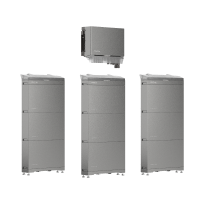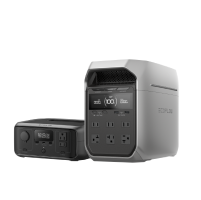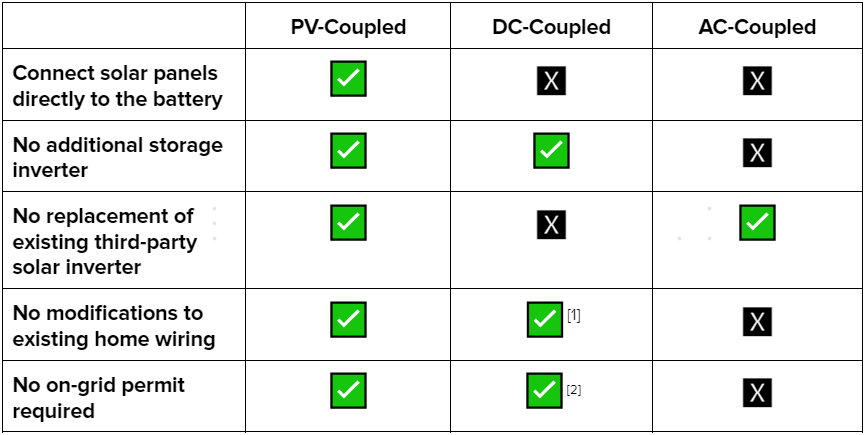Adding Batteries to an Existing Solar System in the UK
If you have a grid-tied solar panel system installed at your home, you already know all about the benefits of renewable energy.
If you’re considering adding solar batteries to your system, you may have already learned about the drawbacks of on-grid solar without storage the hard way.
Renewable energy sources like wind and solar are intermittent by nature. Solar panels rely on sunlight to capture electricity using the photovoltaic effect. They don’t work at night, and output is reduced on cloudy days.
With a grid-tied system, your bidirectional or smart electricity meter automatically toggles back and forth between utility and solar power as needed.
Without a solar battery, you have no control over whether you use electricity from your utility provider during on-peak or off-peak hours — which can cost you a significant amount of money.
Additionally, if you’re not eligible for the Feed-In Tariff or Smart Export Guarantee, any electricity your solar panels generate that’s not sent back to the grid simply goes to waste.
Retrofitting a smart battery system to add storage to your existing solar system is a wise investment.
But where do you start?
Read on to find out.
What kind of product or solution are you interested in?


Can You Retrofit a Battery to an Existing Solar System in the UK?
Retrofitting a solar battery to your existing on-grid solar system is almost always an option.
But until recently, it could be a challenge.
Finding a solar battery with traditional coupling options that’s compatible with all the components of your grid-tied system can be difficult. Aside from choosing the right solar battery chemistry, retrofitting could easily involve purchasing additional equipment like a storage inverter, adding a hybrid inverter, and modifying your home circuit board and wiring.
Depending on your utility company’s policies, you may also be required to apply for a new on-grid permit and inspection.
Thankfully, there’s now a better option for retrofitting storage to an existing PV solar system.
Which Coupling Solutions Are Suitable for Retrofitting My PV System?
Traditionally, Alternating Current (AC) and Direct Current (DC) coupled solar batteries have been the only options for retrofitting storage in a residential solar power system.
Each has its benefits. AC-coupled batteries are typically easier to retrofit and can also be charged using household electricity. DC-coupled batteries are slightly more efficient as no power is lost by converting the DC power produced by solar panels to AC. Solar power is sent directly to the batteries and stored as DC without conversion.

Introducing PV-Coupled PowerOcean DC Fit
Thanks to EcoFlow’s groundbreaking PowerOcean DC Fit solution, direct PV-coupling is now an option.
It’s the easiest and most efficient way to retrofit solar battery storage to your existing grid-tied system.
Check out this head-to-head comparison.

- A change of the wire terminal may be required depending on the output port type of the existing solar inverter.
- Subject to the output power of the new hybrid inverter.

PowerOcean DC Fit features include:
- 6,000+ life cycles (Charges/Discharges) before reaching 70% of original capacity
- Integrated advanced Battery Management System
- Auto-heating during winter or unseasonably cold weather
- Fire protection built-in
Why Would You Choose To Add Batteries to an Existing Solar System?
Two primary reasons exist for adding battery storage to an existing residential on-grid solar power system.
1.Energy Security: Depending on the configuration of your system, adding battery storage gives you home backup power during blackouts and even extended outages. Depending on how many kilowatt hours (kWh) of storage your battery system provides, you can run your home for up to a month (or more).
For example, EcoFlow’s PowerOcean can provide up to 45kWH of storage capacity — and it works off-grid. Unfortunately, PowerOcean DC Fit does not support emergency backup power due to its unique PV-coupling technology.
2.Saving Money: Adding storage to an existing grid-tied residential solar power system reduces your dependence on your utility and helps ensure you maximise your return on investment. If you’re ineligible for the Feed-In Tariff scheme or Smart Export Guarantee, any excess electricity your solar panels generate during daylight hours will simply go to waste without battery storage.
Here is a summary of the main benefits of retrofitting a solar battery or batteries.
- Increased energy security
- Reduced (or eliminated) reliance on the grid
- Intelligent systems like PowerOcean allow you to automatically switch to battery power during peak billing hours from your utility company, saving you even more money on electricity bills.
What Are the Challenges of Retrofitting Batteries To Existing Solar Systems?
Of the traditional methods, AC-coupled batteries are typically better suited to retrofitting to an existing solar power system than DC-coupled.
DC-coupled solar batteries are more suitable for new installations and and new-build homes that don’t yet have existing circuit boards, breakers, andf wiring.
Neither AC or DC-coupled batteries can be connected directly to your existing solar panel array.
AC-coupled solar batteries require a storage inverter. DC-coupled systems require a solar inverter. Depending on the model and manufacturer, additional components may also be required.
With PowerOcean DC Fit’s innovative PV-coupled system, no additional components are required.
Types of Batteries for Retrofitting Into an Existing Solar System
Battery chemistry is an essential factor to consider regardless of whether you opt for AC, DC, or PV-coupled solar batteries to retrofit your on-grid solar system with storage.
Solar battery chemistry determines many crucial aspects of performance, including:
- Charge time
- Energy density
- Cycle life (longevity)
- Depth of discharge
- Range of operating and charging temperatures
- And many other factors.
Let’s examine three of the most common battery types currently used in residential solar installations.
Lead-Acid Batteries
Lead-acid battery chemistry dates back over a century and was the first-ever rechargeable battery technology. For decades, lead-acid and nickel-cadmium batteries were the only options for residential solar power systems.
Ni-cad batteries are slowly being phased out for consumer applications across much of the world. But lead-acid batteries — particularly newer Valve Regulated Lead-Acid (VRLA) variations like AGM and Gel — remain a popular choice for solar applications.
The primary advantage of lead-acid batteries over the more recent technologies we’ll explore below is that they’re cheap.
However, cheap comes at a price. Here are the primary disadvantages of lead-acid batteries.
- Short cycle life (Lifespan)
- Shallow Depth of Discharge
- Requires regular maintenance and frequent replacement
- Bulk and weight
Even the most advanced VRLA batteries typically last for only about 1,500 cycles (full charges/discharges), and many last for only 300-500. Additionally, the storage capacity of lead-acid batteries can be misleading. A shallow depth of discharge often means you can only use around 50% of the battery’s rated storage capacity without causing permanent damage.
Lithium-Ion Batteries
Lithium-ion (Li-ion) batteries are a more recent invention. Li-ion batteries are what power your smartphone, laptop, and many other consumer electronic devices.
Li-ion batteries — and newer subsets like LFP and NCM — are typically the battery of choice for residential solar power systems.
Here are a few of the reasons why.
- High energy density
- Deeper depth of discharge
- High performance
- Fast charging
- Long lifespan
Lithium Iron Phosphate (LiFePO4) Batteries
Lithium Iron Phosphate (LiFePO4/LFP) chemistry is a newer subset of Li-ion battery technology. LiFePO4 is quickly becoming the chemistry of choice in applications that require a significant storage capacity and fast recharge times — like EVs and solar energy systems.
LFP offers many advantages over traditional Li-ion solar batteries.
Benefits include:
- Superior cycle life
- Fastest recharge time
- Lightweight and compact
- Massive storage capacity
- More sustainably and ethically sourced due to the lack of cobalt and nickel
For example, EcoFlow’s PowerOcean DC Fit PV-coupled LifePO4 solar batteries are designed to be retrofitted to existing solar systems.
With 5kWh of storage per battery pack, EcoFlow PowerOcean DC Fit can be expanded to 15kWh and provides 800V of power to start single-phase or three-phase solar inverters independently.
The EcoFlow PowerOcean DC Fit’s LiFePO4 batteries provide 15 years of daily use before hitting 70% of the original capacity. That’s 6000 cycles — backed by a 15-year warranty.
EcoFlow PowerOcean DC Fit has built-in active fire protection, so you know your home is safe. It even provides auto-heating. Even in the freezing cold and rain, you don’t have to worry about keeping your solar batteries within a specific temperature range — it’s even IP65 rated, so you can install EcoFlow PowerOcean DC Fit outdoors under shelter.
Frequently Asked Questions
Is It Worth Adding a Battery To Existing Solar Panels?
Whether your goal is additional energy security or maximising the return on investment from your solar power system, adding battery storage to a residential PV panel array is almost always worth it. It gives you much more control over when (or if) you use on-grid electricity, which can save you a significant amount of money over time.
Final Thoughts
If you’re considering retrofitting solar battery storage to maximise return on investment from your existing solar panel system, there’s no better choice than EcoFlow’s PowerOcean DC Fit.
With up to 15kWh of storage, you’ll have complete control over when — or even if — you use utility electricity.
By using less on-grid electricity overall and none during on-peak hours, you can pay off the cost of the system quickly. And the 800V LiFePO4 batteries come with a 15-year warranty.
Find out if PowerOcean DC Fit is the right fit to add batteries to your existing grid-tied solar power system.



